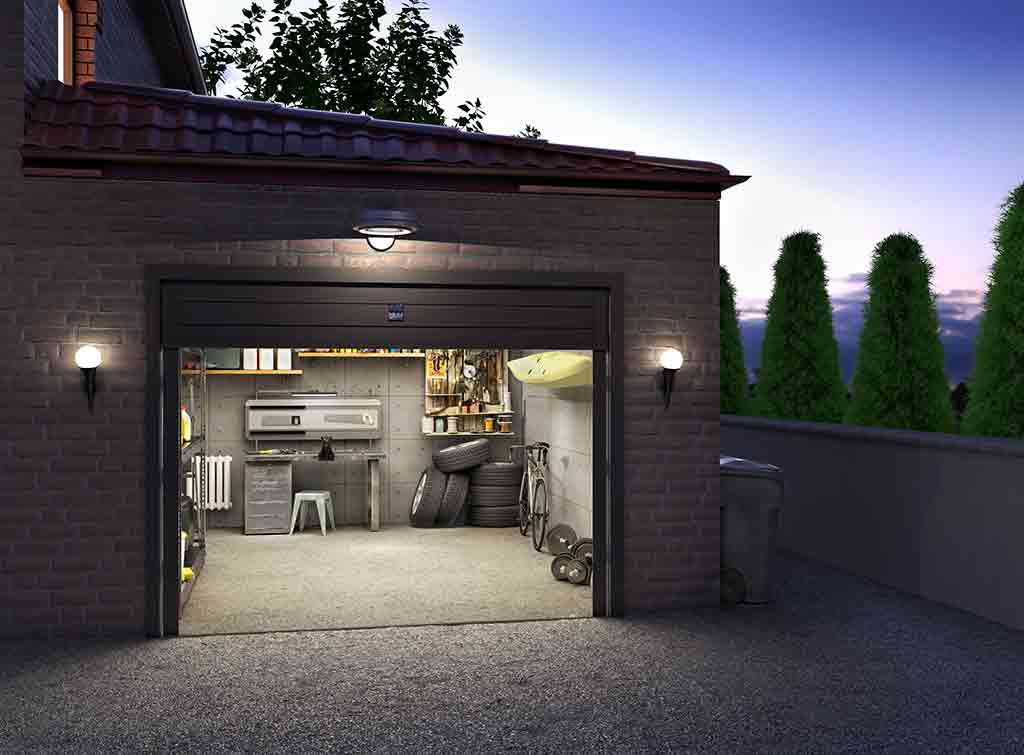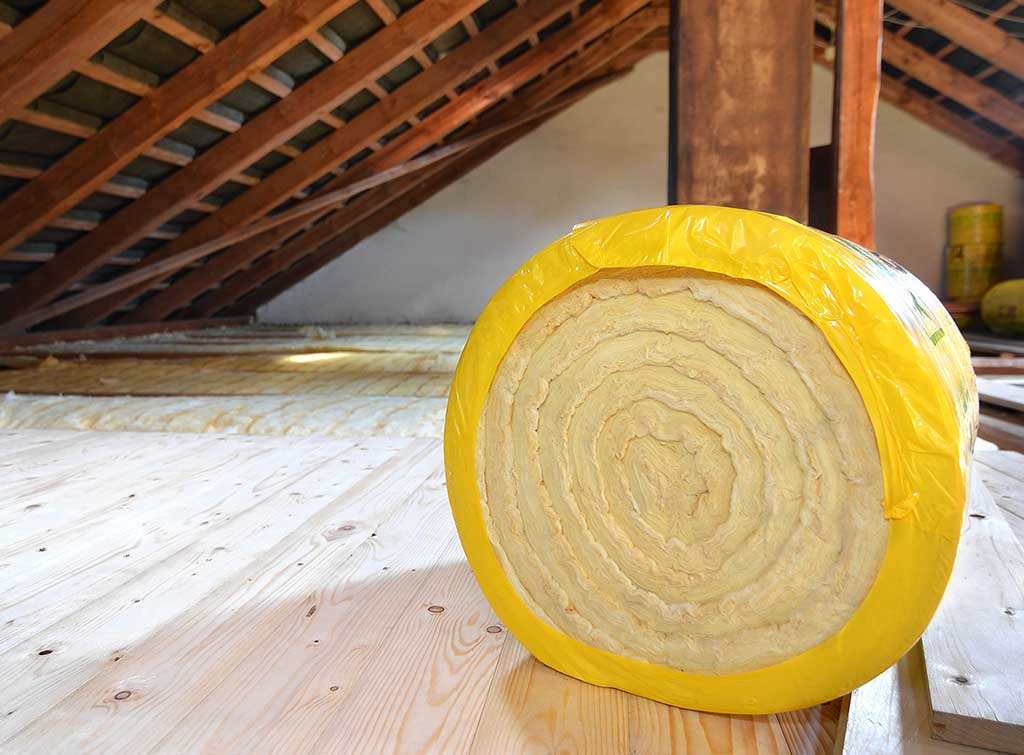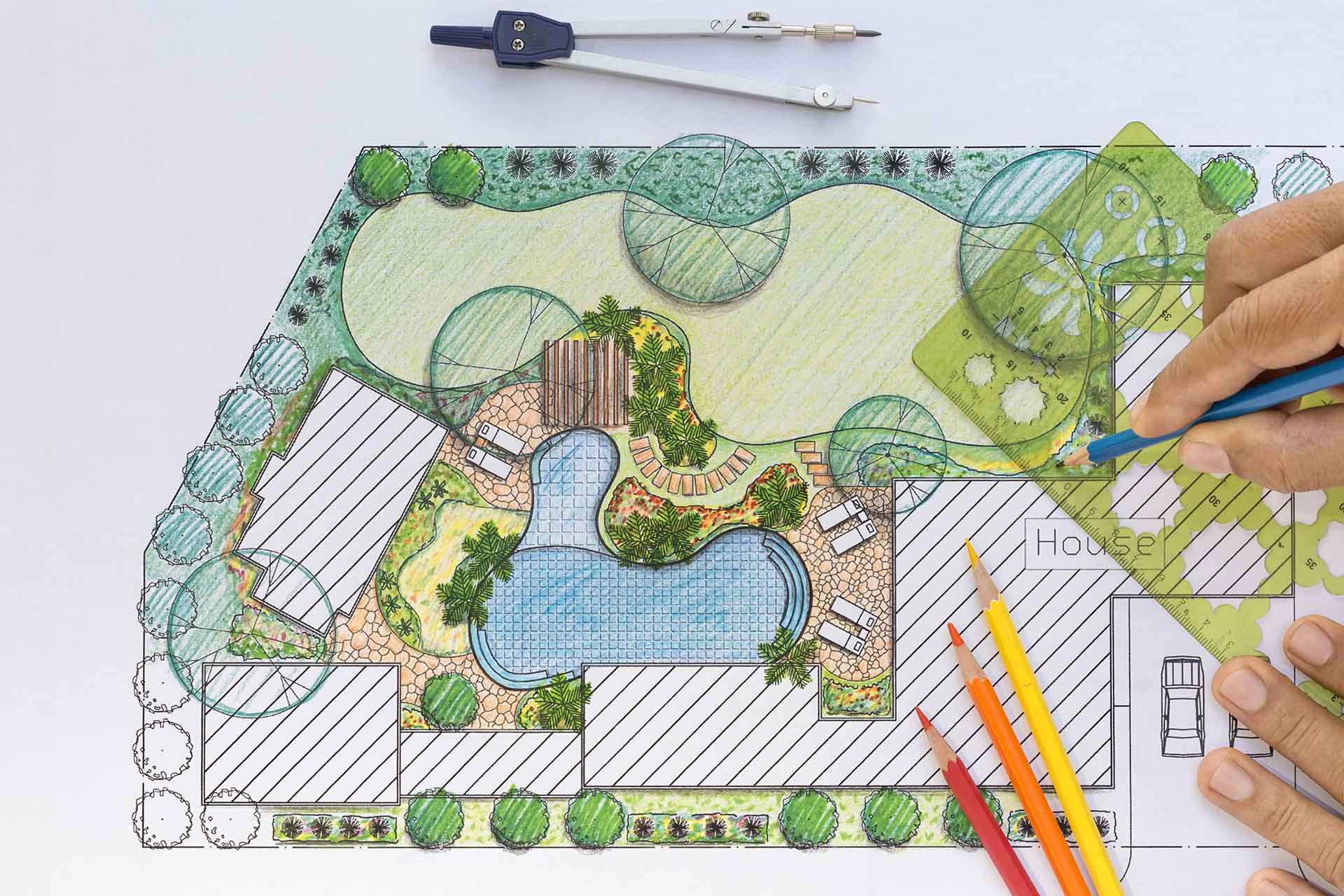Blog>Planning Guides>A complete guide to planning a patio
Last updated: 26 July 2024
A complete guide to planning a patio
Whether you want a small corner of paving for a morning coffee or a large area for alfresco dining and entertaining, planning your perfect patio project is key to its success. Here's all you need to know.

Your patio can make or break your garden. But with so many styles and designs available, planning a patio project can feel overwhelming.
Don't worry. In this complete guide to patio planning, we'll walk you through all the key considerations - from layout and design ideas to paving materials, costs and what's involved in building a patio.
Keen to skip ahead and get a professional to plan the job for you from beginning to end? See which patio laying experts are nearby by searching your postcode below.
See the tradespeople we've checked and recommend for your job
Why plan a patio for your garden?
Adding a patio to your garden has a whole host of benefits. Not only is paving a stylish addition, but it also has an important functional role to play!
Here are some of the main benefits of installing a patio.
Increase your living space
Paving allows you to use your garden as a functional living space. A patio can be a great place to relax, entertain or dine outdoors. It can even make your property feel bigger by giving you more usable space.
Low maintenance
Compared with other outdoor spaces like lawns, patios require very little maintenance. Aside from the odd patio clean and the occasional repair, your patio should last for many years without requiring significant upkeep.
Increase kerb appeal
With so many materials, layouts, and designs to choose from, paving can enhance your home's visual appeal.
Add value
Some studies suggest that adding a patio to your garden could add as much as 20% to the value of your home. Although this isn't a given, it makes sense that adding a beautiful and functional patio to your home could make your property more attractive to potential buyers.
See the tradespeople we've checked and recommend for your job
Patio planning: where to start
There are so many different decisions to make when you're planning a patio. Here, we'll walk you through all the key considerations to help you plan your new paving area with confidence.
But don't worry. Local patio designers will also be happy to help if you get stuck!
Do you need patio planning permission?
Most of the time, you won't need planning permission to build a new patio or install paving around your house.
In fact, there aren't any restrictions on how much land you can cover with hard surfaces at or near ground level.
However, there are a few details to be aware of.
Firstly, you may need planning permission if you need to carry out significant works of embanking or terracing to support your patio - for example, if you live on a sloping site. That's because this may count as an engineering operation.
And secondly, if you want to pave over your front garden, there are restrictions to prevent too much surface water from running off your property into the street and public drainage system.
In essence, you'll need planning permission if you're hoping to pave an area larger than 5m², or you're going to be installing an impermeable material without adequate drainage.
Luckily, this will usually only affect homeowners hoping to install a driveway - head over to our new driveway checklist to learn more.
Ultimately, it's always better to be safe than sorry. So, if in doubt, check with your local council.
Planning a new driveway: your go-to checklist
Planning a new driveway? Here's everything you need to know, including materials, drainage, planning permission, and the all important costs!
How to plan a patio layout
Next, you'll need to plan your patio layout.
The most important thing is to assess the outdoor space available and consider how you want to use your patio. For example:
Where would you like your patio to be located?
How big do you need it to be?
What shape would work best?
Patio location
Many people install a patio adjacent to the back of their home because it offers greater privacy and it's convenient for outdoor dining.
However, it's entirely up to you where to build your patio. If the evening sun hits the top of your garden, and this is where you'd like to enjoy some downtime at the end of the day, go for it!
Existing structures or landscape features, such as a hot tub, water feature, or mature tree might also influence your patio location.
Once you've decided how you'd like to use your patio and its location, you can start to think about the best patio shape.
Patio shape
One of the biggest questions about how to design a patio is how to plan the patio shape.
A square or rectangular-shaped patio is most common, but that doesn't mean you can't choose to have a curved edge to your patio, should you prefer.
Although you don't need to purchase your patio furniture until it's been built, it's useful to start thinking about how you could lay it out now to help inform the size and shape of your patio.
For example, would you like your patio to accommodate one big dining table, or are you planning to create zones? Many people choose to have one area for dining and a separate space for lounging.
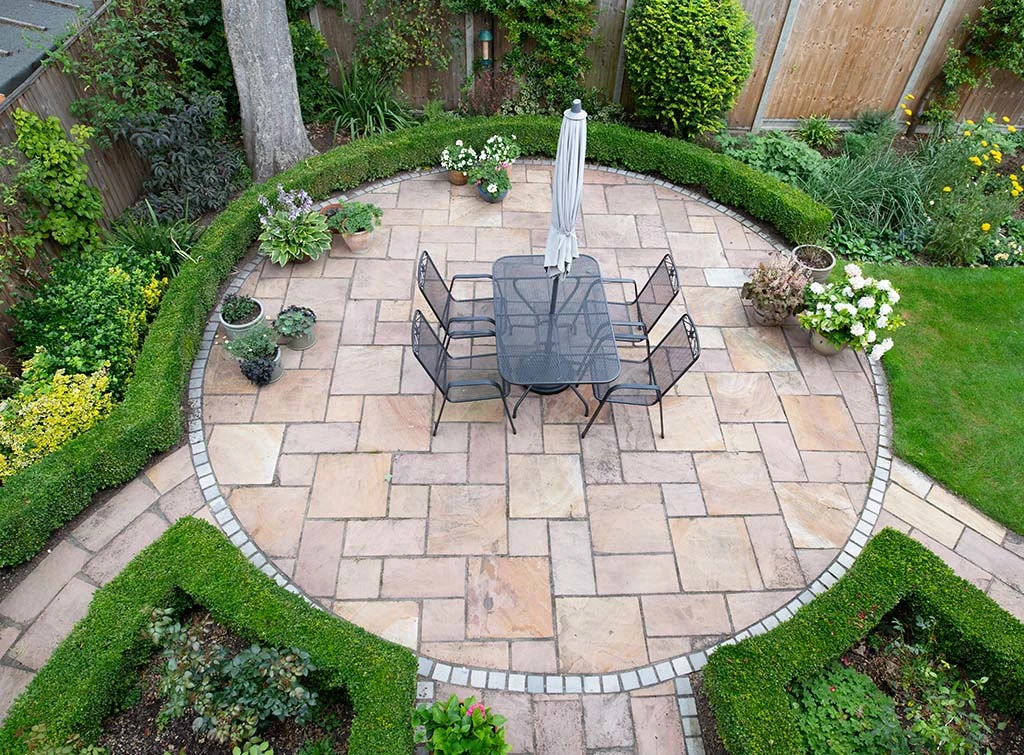
Patio size
Wondering how big a patio should be? The best size for your patio will depend on all sorts of factors, such as the size of your garden and what you plan to use your patio for.
That said, a good rule of thumb is to allow around 2.5m² per person if you plan to use your patio for dining.
With that in mind, the average patio size for a family of four would be around 10m² - or up to 20m² if you regularly host up to eight people!
Similarly, try to leave about 1m between objects such as garden seating, hot tubs or sun loungers. That way, you can make sure people have enough space to move around the patio and avoid a cluttered feel.
We always recommend drawing your patio out to scale or measuring out the dimensions in your garden using rope as a boundary. This way, you can get a good feel for whether your patio is big enough, and how much of your garden it will take up.
Choosing your paving materials
The materials you choose and how you use them will have a huge impact on your finished patio design.
Some common paving materials include:
Concrete
Flagstone
Slate
Limestone
Sandstone
Brick
Granite
Some of the most eye-catching patio design plans involve a combination of materials.
When choosing the right option for your space, you'll need to consider several things.
Aesthetics
When choosing the best materials for your patio, you have several options. You could:
Choose to follow the latest trends
Reflect your home's interior and exterior style
Be completely led by your own tastes and preferences
There are no hard and fast rules—it's your space to design as you wish. However, a good guide is to try to find a happy medium that works for your tastes and the style of your home.
Head over to our stylish garden patio ideas for some of our favourite outdoor patio design pictures.
20 stunningly stylish garden patio ideas
Transform your garden with our fantastic garden patio ideas. From small patios to cottage patios, this guide is overflowing with ingenious patio solutions.
Cost
We'll look at patio laying costs a bit later on in this planning guide. But it's important to take into account your budget when choosing your paving materials.
Brick and basic paving slabs sit at the lower end of the price spectrum. Meanwhile, traditional flagstones, trendy porcelain, slate, and Indian stone sit at the higher end.
If you're struggling to find the right balance between aesthetics and budget, a local landscaper can help to create a personalised plan.
It's worth the investment when designing a patio area you'll want to enjoy for years to come.
Maintenance
The patio material you choose for your garden should align with how much maintenance you're able to commit to.
After all, some materials need more TLC than others to keep them looking their best.
A natural stone patio such as sandstone or slate will be durable and longlasting. However, they may require regular sealing to prevent staining and weathering.
Meanwhile, a brick patio has a rustic charm that is also very forgiving.
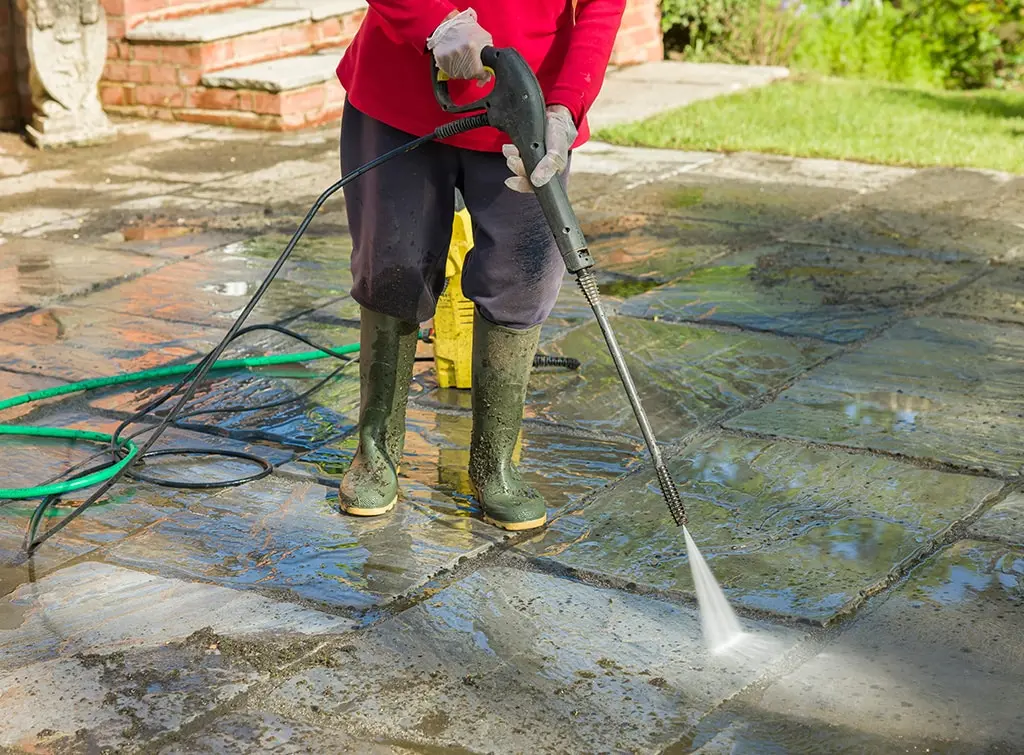
Honing your outdoor patio design
Once you've selected your patio materials, it's time to think about the design elements that will offer the finishing touches.
Patio height
It's important to consider how your patio will fit into the overall look and feel of your garden.
For instance, a sunken patio can be a great way of making your paving area feel like it truly belongs within the landscape.
Meanwhile, a raised patio can be well-suited to a garden that consists of many different levels - and will offer you a great lookout over your outdoor space!

Borders and edging
Borders and edging around your patio can create a neat aesthetic.
They also provide an opportunity to add different types of paving in complementary colours or materials.
For example, Indian sandstone could be edged with brickwork for a modern yet traditional feel.
Check out our garden paving ideas for some inspiration.
Top garden paving ideas for your garden this summer
Garden paving doesn't just look great, and it also adds a practical dimension to your garden. Hardwearing and accessible paths, walkways and patios mean you can enjoy your garden all the more when the sun starts to shine.
Features and accessories
Planning what features or accessories you want for your patio is best done in advance. That way, you can plan ahead for the materials you need.
Built-in seating and outdoor lighting are popular options. Many homeowners build a pergola over their patio for shade or include heaters or a fire pit for warmth.
Don't forget to factor in any plants you'd like to incorporate in and around your patio design. Pockets of greenery can help to create a division between different spaces and soften your patio design. This is where your patio plan comes in especially helpful!
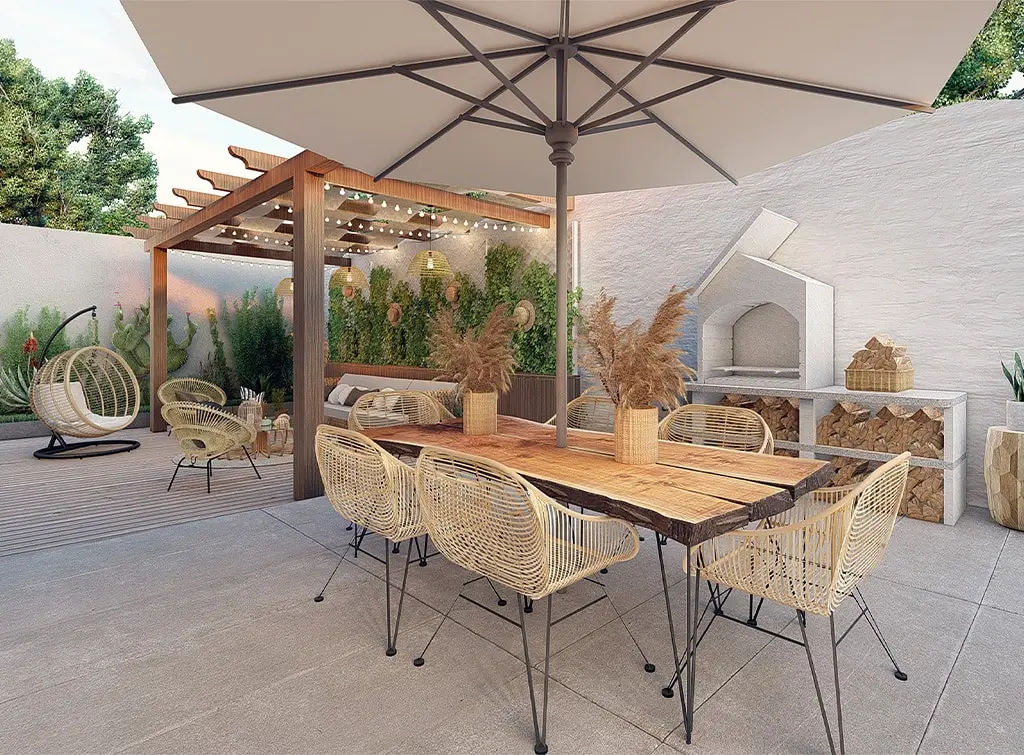
How much does laying a patio cost?
As a guide, a new patio typically starts at around £1,700.
A standard concrete patio starts at around £65 - £120per m², while a flagstone patio sits in the region of £120 - £475 per m², including materials and labour.
However, the total cost of a new patio will vary depending on several factors, including:
The size of the patio
Whether it's a raised patio
The type of patio slabs you choose
The complexity of the patio design and whether it needs drainage channels or soakaways
Your location and any access issues
Whether waste disposal or skip hire is needed
Whether you require any garden landscaping around your patio
Patio laying: Cost breakdown [year]
So exactly how much work is even involved in laying a patio? Patio installation can be a great way to extend your usable space, making a more permanent way to enjoy your garden when the weather in the UK lets you be outside. All you need to know about the costs associated with laying a patio including materials, labour and time frames.
How to stick to your paving budget
Measure your space at least twice to make sure you buy the right amount of paving
Make as many decisions as you can when you're planning your patio, to avoid getting carried away during the build phase
Choose paving slabs that are well within budget to avoid blowing your budget before you've even started!
Be honest about your budget with your contractor so they can work within your requirements
Leave at least 10% contingency to account for any unexpected costs
How to find the right paver for your project
Patio laying isn't easy work.
Not only does it involve hard, physical labour. But without the right experience, it can be difficult to create a solid foundation, lay around any manhole covers, and get the right mortar mix to set the slabs.
With that in mind, finding and hiring the best local patio contractor for your project is vital.
Here are our top tips.
Search a professional directory
A trade directory offers more than just a list of business names.
You’ll only find trades who meet our high standards and pass our checks on Checkatrade.
Contact or pay a trade through Checkatrade and you’re covered by our 12-month guarantee of up to £1,000*

Read reviews
Always check to see what other homeowners have to say about any companies offering patio laying near you. That way, you can make sure to choose someone that others rate.
We check that the reviews on Checkatrade are from real people, and that trades meet our high standards.
Get multiple quotes
It’s best to get at least three quotes from patio contractors in your area.
This will allow you to get a feel for a range of different installers. Plus, you’ll be able to check that you’re getting a fair and competitive price for the work.
You can quickly get multiple quotes using our request a quote feature.
Ask about insurance
Check that the companies you’re considering have the right insurance in place. This will give you confidence that you’re protected in case things go wrong.
You’ll be pleased to hear that all our tradespeople must have up-to-date public liability insurance to get listed on Checkatrade.
Get recommendations
Know someone who’s recently had paving installed? Why not ask if they would recommend the company they used?
Make sure to cross-reference any recommendations on Checkatrade, so you know they’ve also been checked and vetted by us.
See the tradespeople we've checked and recommend for your job
What steps are involved in paving?
Hiring a paving contractor is the best way to ensure your patio is installed to a high standard that will stand the test of time.
However, it can still be handy to understand the steps involved in laying a patio.
Here's what to expect.
1. Measure up the area to be paved
Getting accurate measurements is vital to ensure you don't buy too much or too little paving. It can often be handy to take measurements in both centimetres and inches.
2. Gather the right tools and materials
With the right measurements in place, your contractor will be able to get hold of the right quantities of materials, including your chosen paving slabs.
They'll also need cement, sand, sub-base material and the necessary tools for the job.
3. Prepare the ground
Before your paving slabs can be laid, your contractor will remove the grass and topsoil to reveal the subgrade soil - that's what we call the stable soil beneath.
Then, they'll lay the sub-base to create a solid foundation for your paving to sit on. And finally, they'll apply the bedding layer - usually sand or a mortar mix - to support your paving.
4. Lay the paving slabs
Now, your contractor will be able to lay your paving slabs one by one. They'll do this by wetting them, carefully placing them into position and then using a rubber mallet to gently tap them into place.
Your contractor will usually leave a gap of around 1-1.5cm between each slab.
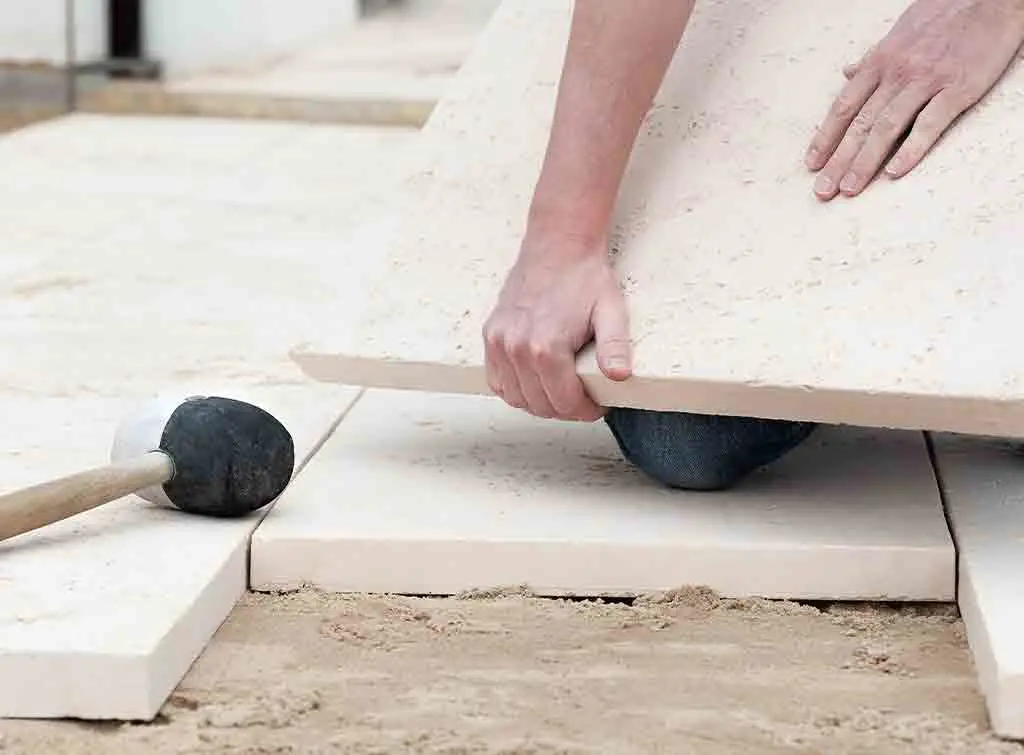
5. Apply the grouting
Once the patio is dry, your contractor will fill the small spaces between the slabs with concrete, using a trowel.
6. Apply any protective seals
Some patio slabs made from certain types of natural stone - like limestone, granite or slate - can benefit from sealing.
Usually, it's best to apply protective seals around three to six months after your patio is laid.
Find the best patio contractors in your area
Ready to bring your patio plans to life? Finding the best patio contractor for the job is easy with Checkatrade.
Simply search your postcode to find top-rated patio contractors in your local area.
See the tradespeople we've checked and recommend for your job
More Planning Guides
More Driveway / Patio Design Articles
See the tradespeople we've checked and recommend for your job





